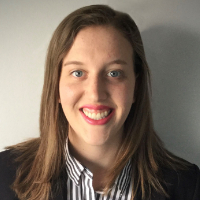Advocating for Rural Health: An Action You Can Take this National Rural Health Day
Published November 18, 2021
By Kaitlyn Thomas, OMS IV, Lake Erie College of Osteopathic Medicine
 I grew up in rural communities in the northeastern United States and currently live in Johnstown, Pennsylvania. This county, as well as several others I’ve lived in over the years, is designated by the Health Resources and Services Administration as a medically underserved area for primary care. As a patient, I know what it’s like to have to travel two hours for medical attention. When I was younger, I suffered from migraines (these luckily no longer affect me today), and while my town had neurologists who treated adults, I couldn’t see them as a patient under 18. There was also a many months’ wait to see the one child neurologist in my town. So, to the city we went to evaluate the migraines that my PCP didn’t feel comfortable handling. Now, as a medical student, when I work with patients who tell me they can’t afford care and aren’t interested in hospital assisted transport, I recognize that I was privileged to make the trip either for a neurology consult or for a second opinion. Many of the patients I’ve worked with want healthcare but are frustrated with the system bottlenecks that prevent them from getting that care. These experiences were a huge factor in why I wanted to attend medical school. Ultimately, as an attending physician, I want to help serve these areas and lessen the burden of travel for care.
I grew up in rural communities in the northeastern United States and currently live in Johnstown, Pennsylvania. This county, as well as several others I’ve lived in over the years, is designated by the Health Resources and Services Administration as a medically underserved area for primary care. As a patient, I know what it’s like to have to travel two hours for medical attention. When I was younger, I suffered from migraines (these luckily no longer affect me today), and while my town had neurologists who treated adults, I couldn’t see them as a patient under 18. There was also a many months’ wait to see the one child neurologist in my town. So, to the city we went to evaluate the migraines that my PCP didn’t feel comfortable handling. Now, as a medical student, when I work with patients who tell me they can’t afford care and aren’t interested in hospital assisted transport, I recognize that I was privileged to make the trip either for a neurology consult or for a second opinion. Many of the patients I’ve worked with want healthcare but are frustrated with the system bottlenecks that prevent them from getting that care. These experiences were a huge factor in why I wanted to attend medical school. Ultimately, as an attending physician, I want to help serve these areas and lessen the burden of travel for care.
Living in these communities, and now serving them during my clinical rotations, I’ve found myself frustrated with care inequalities. During rotations, I often see patients who have traveled an hour or more for primary care. I’ve seen conversations about how to make a trip to the hospital most efficient and that coordinating various appointments for patients is commonplace. I’ve seen older treatment modalities used for patients because they can’t afford the travel required for some newer treatments that necessitate multiple trips or monitoring. My heart breaks every time a family is separated from their newborn baby by two hours or more because that’s the closest NICU with a particular needed service or their insurance plan won’t cover the one 30 minutes away. Throughout my life, seeing this as both a patient and as a physician-in-training, it’s incredibly important to me to expand access to care in these areas. These experiences will inform my practice as a physician because they will be at the forefront of my mind, not an afterthought. I’ve learned these experiences by living them.
Expanding graduate medical education in rural areas is critical to combat the systemic issues that make it difficult to receive care. About 20 percent of the United States’ population lives in rural communities, but only 10 percent of physicians practice there.1 The Rural Physician Workforce Production Act will address these shortages in multiple ways. Proposed solutions include extending more equitable payments to critical access hospitals and sole community hospitals for training residents, increasing support for Medicare reimbursement of urban hospitals that train their residents in rural healthcare facilities and establishing a payment initiative to ensure rural hospitals have resources to bring on additional residents. The act also provides significant incentives to assist rural communities in acquiring residency spots, which will bring medical residents to areas desperately in need of more care. This is one step towards combating health disparities. For these reasons I am advocating for the Rural Physician Workforce Production Act, and you can join me by urging your congressional representatives to support this bill. While this bill won’t address all the shortcomings of the system, it does address a factor that can improve health outcomes—primary care. Increased primary care access is associated with decreased use of other aspects of the healthcare system2 and research has shown that increased primary care improves health outcomes. To help create a healthcare system where everyone, even those in rural communities, can access the care they need, please join me in celebrating National Rural Health Day by taking action today.
Sources:
- https://aspe.hhs.gov/sites/default/files/private/pdf/211061/RuralHospitalsDSR.pdf
- Kravet SJ, Shore AD, Miller R, Green GB, Kolodner K, Wright SM. Health care utilization and the proportion of primary care physicians. Am J Med. 2008 Feb;121(2):142-8. doi: 10.1016/j.amjmed.2007.10.021. PMID: 18261503.
